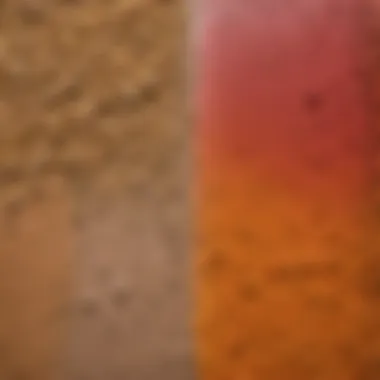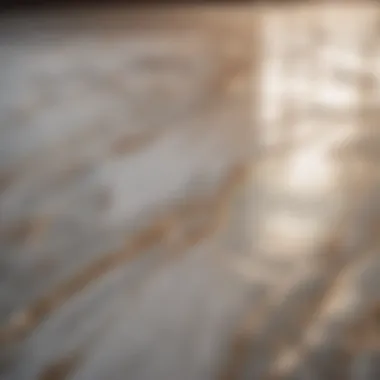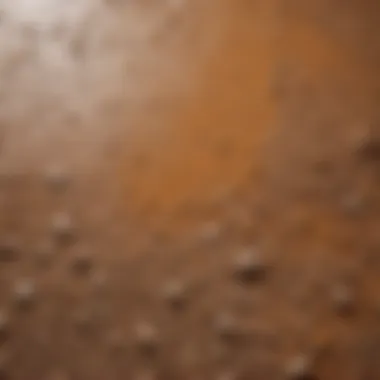Materials:
- Acid-based stain (1 gallon)
- Water-based stain (1 gallon)
- Concrete cleaner (1 quart)
- Bucket(s) for mixing
- Pump sprayer
- Concrete sealant
- Paintbrush(es) or roller
- Protective gear (gloves, mask, goggles)
DIY Steps:
-
Preparation: Begin by thoroughly cleaning the concrete surface with the concrete cleaner. Allow it to dry completely.
-
Testing: Before applying stains, test them in an inconspicuous area to ensure the desired color and effect.
-
Applying Acid Stain: Wear protective gear. Dilute the acid stain as per manufacturer's instructions, then apply using a pump sprayer in a consistent manner. Allow to dry.
-
Applying Water-Based Stain: Once the acid stain is dry, apply the water-based stain using a different pump sprayer or roller. This will enhance the color achieved with the acid stain. Allow to dry completely.
-
Sealing: Apply a concrete sealant to protect the stained surface from wear and tear. Use a paintbrush or roller for an even application.
Technical Aspects:
- Timing: Ensure each stain layer dries completely before applying the next. The concrete should be fully dry before sealing.
- Critical Techniques: Consistency in application is key to achieving an even finish. Take care to protect surrounding areas from stains.
DIY Project Process:


-
Mixing Stains: Follow manufacturer's instructions for diluting both stains. Use separate containers for acid and water-based stains.
-
Application: Work in sections to ensure a uniform finish. Take breaks between sections to avoid overlaps or uneven color mixing.
-
Drying Time: Be patient and allow each layer to dry fully before proceeding. This will prevent smudging or uneven coloring.
Troubleshooting Tips:


- Inconsistencies in Color: Adjust the application technique for a uniform appearance.
- Stain Overlaps: Quickly clean any spills or overlaps to prevent color patches.
Understanding Cement Stain


Introduction to Cement Staining
In the realm of DIY home improvement, understanding cement stain is a fundamental aspect that can elevate the aesthetics of your living space. With a myriad of techniques at your disposal, cement staining offers a creative and versatile way to transform plain concrete surfaces into visually appealing masterpieces.
Benefits of Cement Stain
When delving into the realm of cement staining, one cannot overlook the multitude of benefits it brings to the table. The primary allure lies in the ability to breathe new life into drab concrete, injecting color, texture, and character effortlessly. Cement stains not only add visual interest but also provide a durable and long-lasting finish that withstands the test of time. The customizable nature of cement staining allows homeowners to tailor their surfaces to suit their preferred style, whether it be rustic, modern, or eclectic. By opting for cement stains, individuals can bypass the need for expensive flooring replacements, thus saving time and money in the long run. However, it is essential to note that proper preparation and application are key to maximizing the benefits of cement stains.
Types of Cement Stains
In the realm of cement staining, one encounters a diverse array of options to suit varying preferences and project requirements. Acid stains are renowned for their ability to create striking marbled effects, infusing surfaces with a rich tapestry of tones and textures. On the other hand, water-based stains offer a more predictable and controllable coloring process, ideal for achieving consistent finishes across larger areas. Each type of stain comes with its unique set of characteristics and intricacies, catering to different aesthetic preferences and application techniques. While acid stains provide a beautifully aged and organic look, water-based stains offer a more uniform and contemporary appeal. Understanding the distinctions between these two types of stains is crucial in choosing the right approach for your cement staining endeavors.
Key Components of Cement Stain
Acid vs. Water-Based Stains
The choice between acid and water-based stains is a pivotal decision that influences the outcome of your cement staining project. Acid stains, composed of acid-soluble metallic salts and hydrochloric acid, react with the minerals in the concrete to create a veined and variegated appearance. In contrast, water-based stains rely on pigments that penetrate the concrete surface, offering a wider spectrum of colors and a more precise application process. While acid stains are renowned for their rich earthy tones and natural variations, water-based stains provide greater versatility in terms of color options and customization. Understanding the properties and application techniques of each stain type is essential for achieving desired results.
Color Options
The color palette available for cement staining comprises a diverse range of hues and shades, allowing homeowners to express their creativity and personal style. From warm terracottas and earthy browns to cool grays and vibrant blues, the spectrum of color options caters to various design preferences and architectural themes. Lighter hues can impart a sense of spaciousness and airiness to a room, while darker shades create a dramatic and intimate ambiance. When choosing color options for your cement staining project, consider factors such as natural lighting, existing decor elements, and the desired mood you wish to evoke. Selecting the right colors plays a crucial role in achieving a harmonious and visually appealing finish that complements your living space.
Preparation
In the realm of cement staining, proper preparation is the cornerstone of a successful project. Before delving into the creative part of staining, it is pivotal to ensure that the surface is adequately prepped. This ensures better adhesion of the stain, longevity of the finish, and overall satisfaction with the end result. Additionally, proper preparation sets the stage for a seamless application process and a beautifully stained surface.
Surface Preparation
Cleaning Concrete
Cleaning concrete is a crucial step in the preparation process, as it removes dirt, debris, oils, and other contaminants that could hinder the staining process. By thoroughly cleaning the concrete surface, you create a pristine canvas for the stain to adhere to, resulting in a more even finish. Utilizing specialized concrete cleaners or degreasers can help achieve a spotless surface, ensuring optimal stain penetration and adhesion. This meticulous cleaning process is a popular choice due to its effectiveness in enhancing the longevity and quality of the stain application.
Repairing Cracks
Repairing cracks in the concrete is essential to prevent the stain from accentuating imperfections or creating an uneven finish. By addressing cracks before staining, you ensure a smooth and seamless surface for the stain to work its magic. Utilizing concrete patching compounds or epoxy fillers, you can effectively repair cracks, restoring the integrity of the surface. This step not only improves the aesthetic appeal of the stained surface but also enhances its durability and longevity, making it a beneficial choice in achieving a flawless end result.
Protective Measures
Masking Off Areas
Masking off areas that are not intended to be stained is a crucial protective measure that helps maintain clean lines and prevents accidental staining of undesirable surfaces. By carefully masking off edges, borders, or delicate areas, you can achieve precise and professional results. Using painter's tape or plastic sheeting, you can ensure that only the intended surface receives the stain, avoiding any unsightly errors. This meticulous approach to masking off areas minimizes the risk of staining mishaps, making it a popular choice for achieving a polished and flawless finish.
Using Protective Gear
Employing protective gear such as gloves, goggles, and masks is vital during the staining process to safeguard yourself from potential hazards. Acid stains and certain chemicals used in the staining process require proper protection to avoid skin irritation, eye damage, or inhalation risks. Wearing the appropriate protective gear not only ensures your safety but also promotes a smooth and uninterrupted staining process. By prioritizing safety through the use of protective gear, you create a secure environment for executing the staining process effectively, making it a beneficial choice for a successful outcome.
Application Techniques
DIY Acid Staining
Preparing the Acid Solution
Preparing the acid solution is a crucial aspect of the DIY acid staining process. It involves blending acid with water to create a potent solution that reacts with the concrete surface, imparting rich, variegated tones. The key characteristic of preparing the acid solution lies in its ability to etch the concrete and allow the stain to penetrate deeply, resulting in durable and long-lasting coloration. This method is favored for its ability to create organic, mottled effects that mimic natural stone, providing a unique and sophisticated finish to the surface. However, it is essential to handle acids with caution due to their corrosive nature.
Applying the Stain
Applying the acid stain is a critical step in the DIY cement staining process. It involves methodically spreading the prepared solution onto the concrete surface, ensuring even coverage and absorption. The key characteristic of applying the stain is its transformative effect on the concrete, as the color develops and intensifies over time. This method offers a range of design possibilities, allowing for expressive and artistic results. However, it is important to note that the outcome of acid staining can be unpredictable, adding to the charm and uniqueness of each project. Careful application and attention to detail are key to achieving desired results with this technique.
Water-Based Stain Application
Mixing and Application
When it comes to water-based stain application, mixing and applying the stain require precision and expertise. The key characteristic of water-based stains is their eco-friendly nature, making them a popular choice for those seeking a more sustainable staining option. Mixing the stain to achieve the desired color intensity and consistency is essential for a successful application. The unique feature of water-based stains lies in their versatility and ease of use, making them suitable for both indoor and outdoor projects. While water-based stains offer a wide range of colors and finishes, they may require multiple coats to achieve the desired look. By understanding the intricacies of mixing and applying water-based stains, individuals can create vibrant and customized surfaces that enhance the beauty of their living spaces.
Finishing Touches
In the realm of exploring DIY cement staining techniques, the phase of Finishing Touches plays a crucial role in the overall outcome. This section focuses on the final steps that elevate the stained surface to a professional finish. One of the key elements covered in this section includes the sealing of the stained surface, which not only enhances the aesthetic appeal but also provides longevity to the newly transformed concrete.
Sealing the Stained Surface
Benefits of Sealing
When delving into the benefits of sealing the stained surface, it becomes apparent that protection is paramount. The application of a sealer ensures that the stained concrete is shielded from external elements, such as moisture, dirt, and stains. Moreover, sealing enhances the color intensity of the stain, prolonging the vibrancy and depth of the hues while offering UV protection to prevent fading. This protective layer also simplifies maintenance by making the surface easier to clean and maintain over time. In the context of this article, focusing on the benefits of sealing underscores the importance of preserving the beauty and integrity of the stained concrete surface.
Sealer Application
Moving on to the practical aspect of sealer application, understanding the process is essential for achieving optimal results. The key characteristic of sealer application lies in its ability to provide a seamless protective coating that adheres securely to the stained surface. This enhances durability and longevity while maintaining the aesthetic appeal of the concrete. The ease of application and the versatility of sealers make them a popular choice for DIY cement staining projects. The unique feature of sealer application is its ability to enhance the overall look of the stained concrete, offering a glossy or matte finish based on the homeowner's preferences. While sealers provide numerous advantages in terms of protection and maintenance, it is crucial to follow the application instructions meticulously to avoid streaks or inconsistencies, ensuring a flawless finish that elevates the visual impact of the space.
Maintenance Tips
Cleaning and Care
The meticulous care and cleaning of a stained concrete surface are vital to maintaining its pristine condition. Incorporating cleaning and care routines into regular maintenance schedules ensures the longevity and vibrancy of the stained finish. The key characteristic of cleaning and care involves using appropriate cleaning agents that are compatible with the sealer to avoid damage or discoloration. Regular cleaning helps remove dirt, dust, and stains that may accumulate over time, preserving the beauty of the stained surface. The unique feature of cleaning and care lies in its ability to rejuvenate the appearance of the concrete, restoring its sheen and luster. While cleaning and care routines offer numerous advantages in terms of upkeep and visual appeal, it is essential to follow manufacturer guidelines and recommendations to maintain the integrity of the stained surface.
From sealing to maintenance, each aspect of finishing touches contributes to the overall success of DIY cement staining projects, ensuring lasting beauty and functionality for homeowners looking to transform their concrete surfaces.





